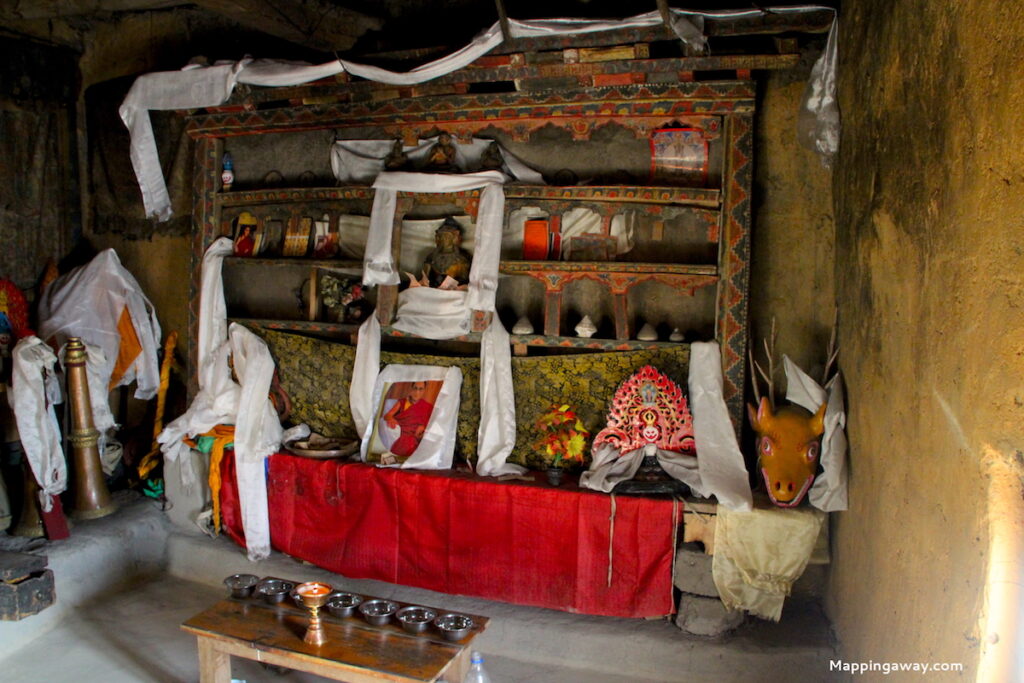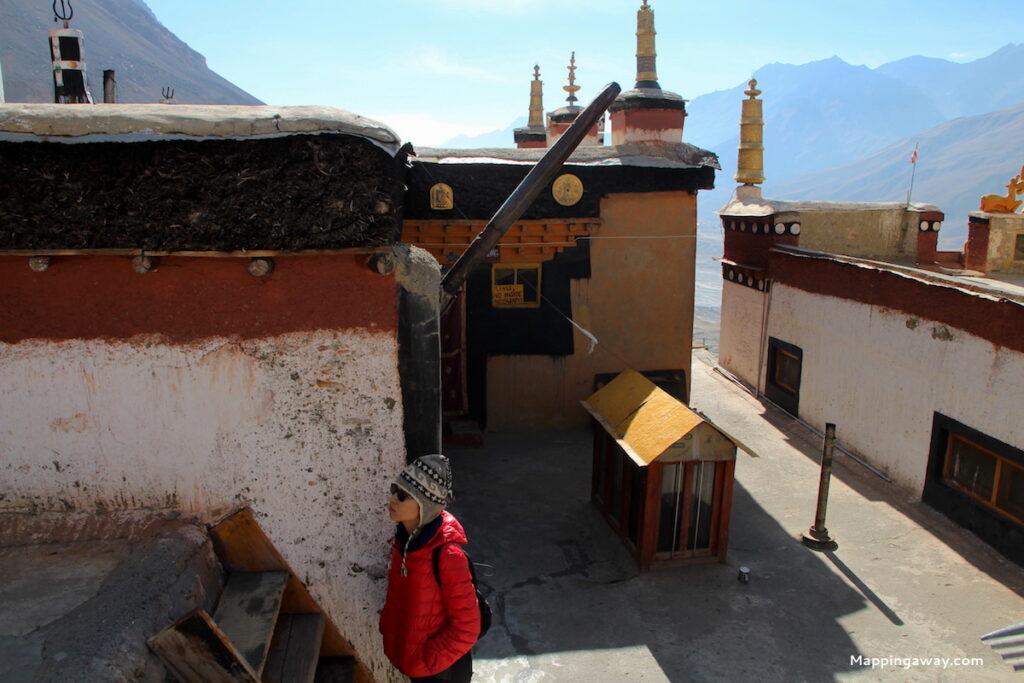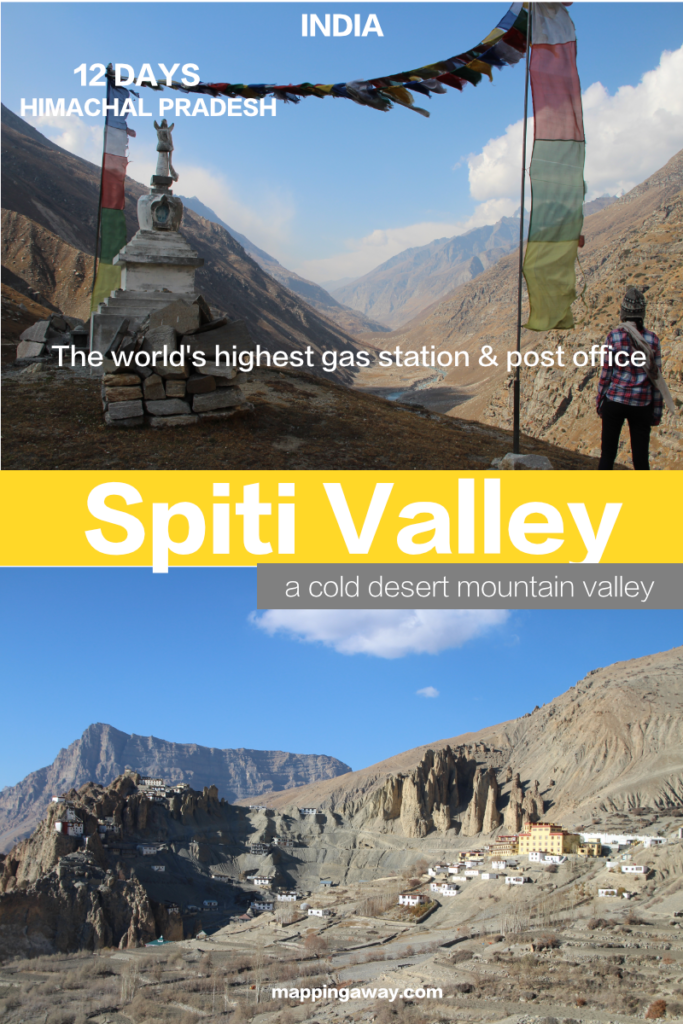Spiti Valley is an out of space and time destination. When you are here, the time has been forgotten. After Rohtang Pass, the straight paved road connects to Ladakh and the unpaved road goes to Spiti Valley. This shows the economic/tourism development variance of these two valleys.
As driving into the valley, everywhere is a pit stop for a great photo opportunity. The Spiti River wounds through the infinite-deserted landscape like a lonely rattlesnake moves in the sand dunes. Driving after miles on the bumpy dirt road, the first shop finally came to eyesight. A jeep of passengers leaving the valley for the coming winter. Once the snow arrives, the roads are blocked and mobility is nearly impossible. We arrived in early November. Sights of snow on our day leaving the valley.
3 Days is a very short trip to Spiti Valley. It’s enough time to have a glimpse of the valley and visit famous spots. But if you travel slow and want to stay in villages, 7 days would be perfect. November might not be a great month for pleasant treks. But packing thermals and thick clothing would still be helpful.
Best Time to Visit
March to June is the best time to visit Spiti Valley as the temperature gets warmer and activities accessible. The Shimla-Spiti route, the only route open at this season.
Late September to November is the autumn season marked the end of monsoon and the beginning of winter. It is still a good time to visit the valley.
Monsoon is from July to September. The Manali – Spiti route opens up based on weather conditions. The disadvantage is the tourist crowd and possibilities of landslides and floods.
November to March is the least favorite season but the best season for leopard spotting trek. If you are lucky, a leopard would be spotted. The valley covers in snow and temperature run below -15 Celcius. Agencies actually organize this trek.
Routes to Spiti Valley & Border Permit for Non-Indians
Shimla-Spiti Route – I absolutely enjoyed this route despite my border permit was refused at Reckong Peo border police office. You need two or more non-Indian passport holders in a group to apply for the border permit (exit and enter).
Shimla – Narkanda – Rampur – Kalpa – Nako-Giu Village – Tabo Village – Dhankar – Pin Valley (Mud Village) – Kaza – Kunzum Pass – Manali
Tip: If you happen to be in the same situation as me, spot solo foreigners in Reckong Peo bazaar :). I did not have much luck traveling in November
Manali – Spiti Route is a popular and well-used route. I definitely recommend the drive from Shimla -Spiti Route and end your trip in Manali or another way around if you get the permit.
Manali – Solang Valley – Rohtang Pass – Gramphu – Batal – Chandratal – Kunzum Pass – Losar – Kaza
Spiti Valley Transportations

Hire a car with a driver – this is the best option and travel comfortably. The road condition permits speed from 10 to 15 km/h for 6 hours. An SUV / jeep is recommended. I saw a broken Civic Honda abandoned on the roadside.
Rent a Motorbike & Scooter / Bicycle – these are great for solo or group adventure seekers. Two solo women travelers on a bicycle and scooter shared the road with me.
Public Transportation – This is a budget and slow travel to and around Spiti Valley. HRTC runs everyday buses to towns and Kaza. Check for the weather conditions. Bus Schedule & Bus Schedule 2
Where to Stay in Spiti Valley?
Countable guesthouse available in Kaza and Tabo. Do not have to set up a travel base if you are a ready to pack and go type. Monasteries commonly have accommodation available, like the Dhankar Monastery Guest House, and for the smaller monasteries, you have to walk in and inquire.
Tip: Many are closed during winter. Only a few locals might maintain their homes for guests. Lowering your expectation would guarantee an enjoyable trip :).
Kaza
Karze: Mud House, Homestay
Khankar Home Stay
Tabo
Namsay Homestay Tabo
Langza
Lara’s Homestay
What to Eat in Spiti Valley?
In Kaza, the capital, and Tabo, you will find restaurants that serve traditional Tibetan foods, like thukpa, tingmo, momos, butter tea, and tsampa etc. I love the mutton momos. It’s juicy I could have a plate for myself :). Of course, you will get vegetarian food and momos. I am not sure about halal, kosher, etc.
About Spiti Valley

Spiti means the Middle Land. It’s a middle land between Tibet and India. Hikkim’s highest post office in the world and Kaza’s highest gas station in the world are found in the valley. The unusual terrain, the high mountain desert, and the cultural heritages are the main attractions.
Spiti Valley shared the border with the Ngari Prefecture of the Tibet Autonomous Region (PRC). As earlier as the 7th century, Tibetan traders followed the trade route by crossing the Central Asian (Pamir Mountains) to Kashmir, Ladakh, and to Tabo. Between the 8th to 9th centuries, the Old Tibetan Empired’s expansion brought culture and religion to the native inhabitants in this region. The local cultures (Bon) influenced Tibetan culture as a result of various aspects of Tibetan cultures were formed. Arts and Architectures in Spiti Valley are documentation of this period in Western Himalaya.
The traditional socio-economic structure of Spiti villages is dominated by a group of households namely Khangchen, the old soldiers, or local militias. About 285 Khangchen households spread out in the valley have ownership rights to all village farming land and irrigation sources. The other groups work for them in the village.
The locals speak a dialect of the Western Tibetan Group. In 1846, British India annexed Spiti and Lahul. Agro-pastoralism is the main source of livelihood for the inhabitants. The sect of Buddhism that practices in the Valley is Gelug or “Yellow Hat”, Dalai Lama is the religious leader. Monks have the opportunity to study at Gaden Jangtse Monastic in South India.
No-Man’s Land: On the Road to Spiti Valley in Early Winter
The journey is lonely. It is a one day journey to get to the capital of the valley, Kaza. The paved roads are limited to some distances. We started at 8 am from Manali and arrived at Kunzum Pass around 2 p.m. You might think 2 p.m is not that bad and only 75 km from Kaza (1 hour). In November, sunset is between 4 to 5 pm and driving on half gravel and paved roads do not make it in a one hour trip.
If you are not skillful in driving on gravel, just drive slow, no rush!
Tip: Start as early as possible. I met some people start at midnight. Plan well and stay safe! 🙂

Folds of mountains lie on our eyes’ horizons. We follow the river and chase after the sun. At this moment, I love the sun and crave warm sun rays. I definitely called this a No-Man’s land. In winter, shepherds take the herds elsewhere, no sight of them other than in towns. Up to Kunzum Pass, no houses or few abandoned houses and a soul. River beds cover in brown grasses waiting for summer to come. Only one shop opens for lunch that serves maggie. It’s best to pack some snacks with you. Grab a hot drink!
Kunzum Pass: 4,551 meters
The road slowly ascended. You would not feel even at 4,000 meters elevation. Kunzum Pass marks by the prayer flags that you won’t miss. Prayer flags rant as strong wind gust at the empty ground. With the sun blocked by the mountains, the temperature drops instantly.

Yaks and Villages
Farmlands are let to rest in wintertime. From distance, yaks gaze at dried grass from the fields. Summer must be an oasis. Most villages settle near the river for water resources reasons. Traditional cultivation methods are usually used. Barley, black peas, and potatoes are the staple diet. They also grow green peas and fruits like apples and seabuckthorn. Don’t be a picky eater while in Spiti Valley :).

Firewood
Firewood is a commercial product in the valley and delivers by truck from outside. It’s an obvious observation that the desert mountains are not suitable for any vegetations. Kerosene is a subsidy by the government. Trucks drive from village to village to deliver to households.
Day 2: Tabo Monastery & Dhankar
Morning is freezing in Kaza. Dog gangs occupied the streets. It’s a rush day to visit Tabo and Dhankar.
Thermal is a necessity to get good sleep. Where we stayed, the hotel was at its last few days into operation. All goods were in storage. Water pipes freezing in the morning is common in cold weather.
The drive to Tabo is both pleasant and jaw-dropping. Driving through the stunning and vast mountainous landscape. It’s like there is no end to the road. Another landscape mark is the varieties forms of rocks are created by rain and wind. Areas near Dhankar are stood out for the shapes of mountains. Most part of the road is paved to Tabo. Pay attention to the bushes – we spotted Musk Deers poaching in the woods. And I spotted the only shepherd-of-the-day herding goats. I believe those trees are orchards on the opposite of the river. Yellow leaves decorated the river bank.

Goat Herd 
Musk Deers
Tabo Monastery: Tibetan Himalaya Art Style
Built on flat land in the 10th century, Tabo Monastery is not just the only oldest monastery in the valley as well as the oldest operating Buddhist monastery in India and the Himalayas. It’s a must-visit for Buddhism art lovers.
The monastery maintains its muddy color exterior as a contrast to the white-washed plaster exterior of the other monasteries. Traditionally, the second son becomes a monk in Spiti Valley. This was the only education they received. Nowadays the valley has gone through changes.
Phase I ca.996 : Old Entry Hall
Tabo Monastery plays an important role in the history of Buddhism. The wall paintings, artifacts, and other art pieces host in the monastery’s Old Hall Entry are defined as Tibetan Himalaya styles. The style only found in the 8th to 11th centuries in this region. The term “Tibetan Himalaya Style” coined by scholar, Deborah Klimburg-Salter.
A young monk would open the door for you to the Phase I dark room, the old entry hall. Carry flashlight! The lightbulb is dimed, not enough to shed light on the murals. This is a spectacular room decorated in murals, including the paintings of the founder and his two sons. It is the best representative of the Tibetan Himalayan style that evolved before the 8th century (Klimgbur-Salter). They are well-preserved. Paintings including the social hierarchy, like royal family members, are painted on the Entry Hall walls. The sizes of the figures are important; it’s to tell their power in society.


Old Entry Hall 
Phase II ca. 1042: Renovation Period
The monastery went through a renovation in ca. 1042 by the founder’s grandson in Kashmiri influenced Indo-Tibetan art style. The paintings in Entry Hall and Assembly Hall show different schools of art from the Old Entry Hall. This also shows a significant change in social and political contexts. In Phase II ca. 1042, only royal lama surrounded by monks and laymen have painted on the wall. Where are the local princes? Their disappearance reveals power shifting in the valley.
Pinpoints the differences if you visit the new and old Entry Hall. During my visit, I missed the morning chanting and the new Entry Hall was locked. It would be a great experience if you stay in a guesthouse in Tabo and attend the morning chanting.
The souvenir counter sells paintings and postcards in case you did not have a good look at the Old Entry Hall. If you are into Tibetan incense, they are available as well.
The earthy color of the monastery and stupas blend into the landscape as a whole. Stupas built in a simple style, not enormous. Some stupas are out of shape-shedding off. You can see the wooden structures.

Mutton Momo’s for Lunch 🙂
Dhankar Gompa: 3,894 meters
Dhankar is a not-to-be-missed destination. The 1,000-year-old fort and monastery built in a strategic location. Dhankar built on an elevation of 3,894 meters cliff overlooking the vast valley landscape and the Spiti Valley. It is believed that the first ruler of Spiti laid the foundation of the fort and monastery. It was an administration office and center of religious activities. From the information was given by the monastery, the village and the monastery were attacked by bandits in the olden days.
Breathtaking view from the monastery’s back door. The cliff soils are being shaped by wind and rain throughout the years. The monastery hosts the deity of Dhyana Buddha (Thinking Buddha), and a large number of scriptures in the Bhoti language. New housing developments can be seen below the monastery. Dhankar village is below the monastery. A most peaceful place to be for one week retreat.

When we arrived, a middle-aged monk opened the door. He had recently come back from South India. The hall is actually smaller than we thought. Interior designed in a simple style. Narrow steps and small entrances – watch out for your head. Lights pass through a small window. The fort-monastery could only increase in height.
Day 3 Leaving Spiti Valley
The trip was so short that end on the third day. Before we heading back to Manali, we visited the Key Gompa. It’s our final destination. We started as early as possible. When we arrived, the monks were peeling potatoes by the stairs, preparing for lunch.
On the way to Key Gompa, you must pass through a village. You probably have noticed firewoods are stored on the roof found in every village. I believe it’s for the birds to build nests and stay throughout the winter. The harsh environment does not provide enough vegetation for biodiversity.
Kye Gompa: 4,116 meters
Kye Gompa is the largest gompa in the valley, built-in around the 11th century. A colorful gate welcomes you to the gompa. Even we arrived at 9 am, the prayer room and rooms are locked. The key person has nowhere to be found. We left to explore the exterior of the gompa. Similar to Dhankar, the strategic position offers it a splendid view of the valley and the Spiti Valley. You could stay here for a month, just inquire. I personally prefer Dhankar :).

The gompa is known for its ancient murals and rare thangkas. In a fort style, the gompa has three levels. Part of the gompa was destroyed in the 1975 earthquake and rebuilt.

Last Glimpse of Kye Gompa from Distance
As drove to the opposite of the river, Kye fortress shrinks back against the enormous mountains.

Festivals
Ladarcha Fair is celebrated in August in Kaza as the main cultural observation for tourists. Previously hosted in Kibber village as a market for farmers from Kullu, Kinnaur, and Lahul to barter theirs products. Other festivals are celebrated in the valley are Tsheshu Fairs and Fagli, and Gustar Festival host in Kye Monastery.
Essentials to Pack for Early Winter
Thermals; Beanie; Gloves; Lightweight Warm Jacket; Hiking Shoes; Water Bottle; Instant or Coffee Grounds; Chocolate or Snacks; Travel Journal; Medicines; Toiletries; Toilet Tissue; etc.








